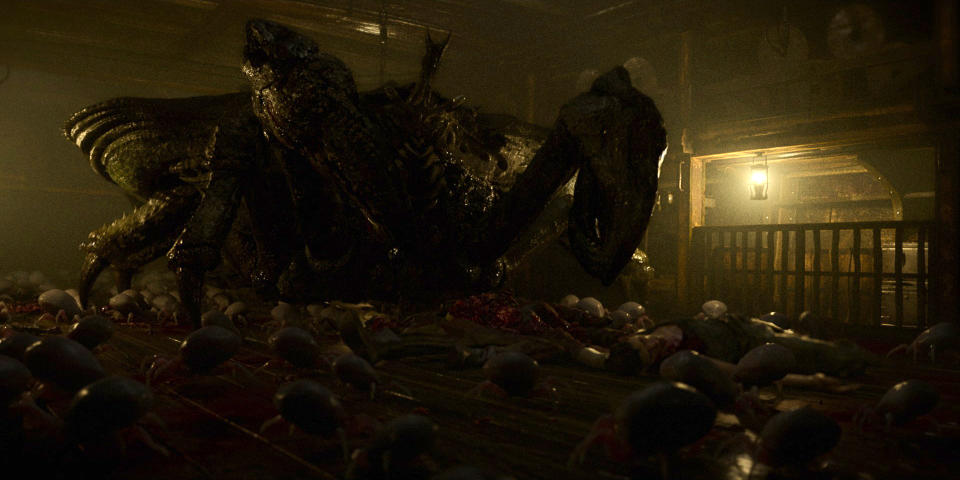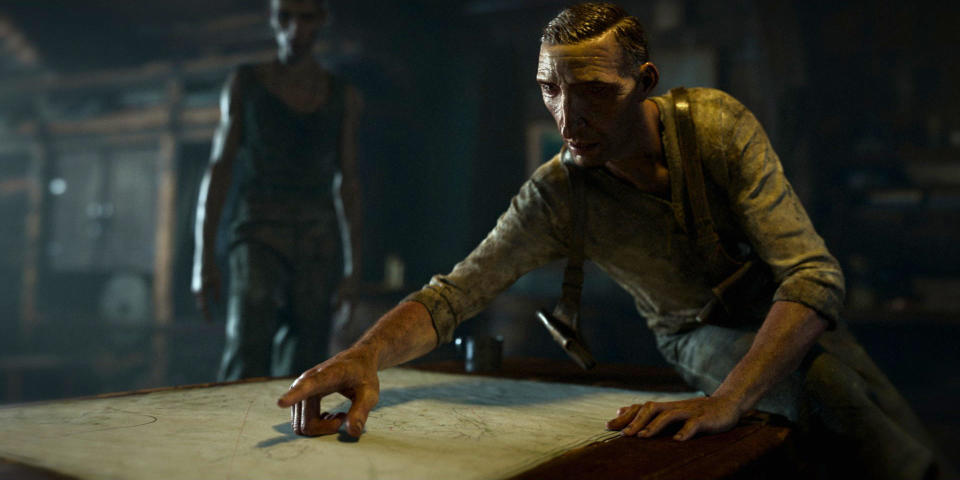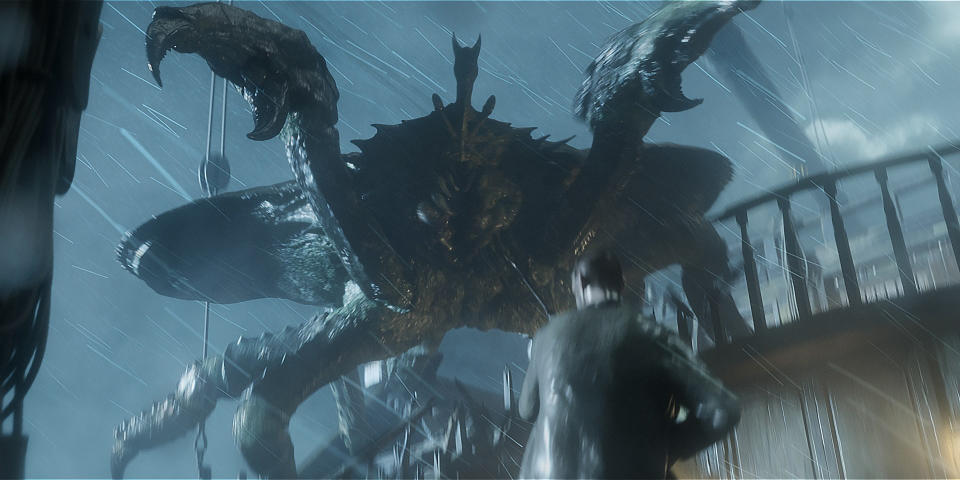‘Love, Death + Robots’ Season 3: David Fincher Gets Animated for the First Time on ‘Bad Travelling’

- Oops!Something went wrong.Please try again later.
It’s easy to see why David Fincher chose “Bad Travelling” as his first foray into directing animation. He made his feature debut with the ill-fated “Alien 3,” after all, and the premise of this third-season episode of “Love, Death + Robots” is a bit like setting the plight of the Nostromo on the high seas: A giant, slimy crab devours the crew of a shark-hunting vessel, with only the cunning navigator surviving to battle the beast. (It also makes up for Fincher’s aborted take on “20,000 Leagues Under the Sea” at Disney.)
Fincher also likens “Bad Travelling” to “Ten Little Indians” meets “Deadliest Catch,” with the ship’s navigator, Torrin (Troy Baker), contending with mutiny, betrayal, and a starving Thanapod crustacean that bizarrely communicates through ventriloquism.
More from IndieWire
But, of course, it was the grotesque, slimy xenomorph, hatched by legendary biomechanical designer H.R. Giger, that Fincher especially loved about “Alien,” and why he paid so much attention to the Thanapod. “David wanted [the Thanapod] disgusting and to be confusing,” Blur Studio animation supervisor Hubert Daniel told IndieWire. “The mouth doing one thing, legs and pincers doing another thing. He kept asking for more goo and more saliva.”
Daniel made a one-minute CG animation test after the design was approved by Fincher and Tim Miller (his co-creator on “Love, Death + Robots,” who founded Blur and directed “Deadpool”). They studied crabs and scorpions, and arrived at the menacing Thanapod, which was the size of two Range Rovers side by side. Fincher preferred the look and movement of a crab, and rejected the idea of a scorpion tail.

“The mouth was one of the things I tested out that David liked,” Daniel said. “It completely folds on itself and closes with a slit of flesh. But then it can open, revealing fangs, little teeth, and tentacles. When it’s talking and gets more agitated, the mouth moves more, the tentacles undulate, the eyes start twitching. It also has gill-like openings in the front of the mouth for breathing that I moved for ventilation.”
But there’s a twist: The Thanapod is female and gives birth to hundreds of babies once it starts consuming crew members (another nod to the “Alien” franchise). “It grows larger and moves slowly, dragging its belly on the ground, and it gets too big to get out of the [hull],” Daniel said.
The animated performances were motion-captured to get facial and body reference. The entire short was shot in the volume with reference cameras and a few props and set dressing. There were around 10 actors and stunt performers directed by Fincher. They rehearsed and shot 300 master setups (15 to 25 takes each) to get the range of emotions and movement for each character that Fincher required. The footage was then assembled for the director to review, and the mocap takes that he approved were cleaned and sent to the animators. They then took the data to re-target on the 3D models (influenced by the actors’ features). The character animation was stylized and slightly caricatured to match the retro look of the ship environment.

Netflix
“I set up the process similar to a live-action shoot and ahead of time we talked through what the environments were going to be like,” Aaron Weldon, 2nd unit director and layout supervisor at Blur, told IndieWire. “We then blocked those out, made sure they had the proper scale of the crab, what the different rooms would be, what the props were. We could rehearse and shuffle things around, make the rooms larger. The nice part for David was he’d run the whole scene as a master, and then break up more specialized inserts to focus on key performances.”
Weldon and the layout team meticulously researched Fincher’s work to achieve his signature look, depth of field, symmetrical compositions, and lighting style. “We used the specific 35mm camera and lens package that he picked out [for the virtual shoot],” he said. “It has the same film back for digital cameras for the same depth of field that he likes. For the most part, he locks his cameras off; he likes being very symmetrical, either straight on, or perfectly at 45 degrees.” For live-action, Fincher shoots with a customized Red digital camera and Summilux lens.

Netflix
The most complex sequence was the climax, where the Thanapod chases Torrin up a spiral staircase after he sets the ship on fire. To enhance the realism, Fincher insisted on constructing a 10-foot wooden model of the staircase to shoot in the volume. “It’s four different mocap clips,” Weldon added. “The actor fires the gun, throws it down, turns, and runs toward the stairs and starts to go up. We then mixed in the stunt guy sprinting up the stairs, tumbling, and hitting the wall and coming up the top of the stairs. We cut to the stunt guy running out the ship’s door, sprinting across and leaping. And then we cut to another shot where he leaps off the ledge down into the water.”
For Daniel, the chase with the Thanapod comprised his best work on the short. It’s one really long slow-motion shot. The only disagreement he had with Fincher occurred during the chase. “I wanted to have a tentacle that reaches out and wraps itself around Torrin’s neck,” he said. “David thought it was too rubbery. And I kept saying, ‘Trust us: it will look good when it’s finished.’ Tim agreed. We kept the particles, smoke, lighting, shadows — proper texture sold the look. And he liked it.”
Best of IndieWire
The Best 30 LGBTQ Movies and TV Shows Streaming on Netflix Right Now
10 LGBTQ Film and TV Creators on the Rise, from Jerrod Carmichael to Isabel Sandoval
Sign up for Indiewire's Newsletter. For the latest news, follow us on Facebook, Twitter, and Instagram.


